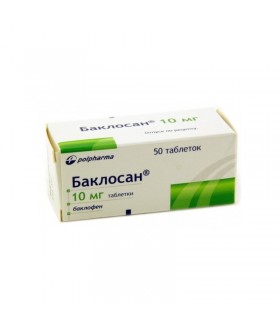




Security policy (edit with Customer reassurance module)

Delivery policy (edit with Customer reassurance module)

Return policy (edit with Customer reassurance module)
Pills white color, round, biconvex, with dividing risk.
| 1 tab. | |
| baclofen | 10 mg |
Excipients:lactose, potato starch, gelatin, talc, Magnesium stearate, ethylcellulose.
50 pcs. - polypropylene cans (1) - cardboard packs.
Pills white, round, biconvex.
| 1 tab. | |
| baclofen | 25 mg |
Excipients:lactose, potato starch, gelatin, talc, magnesium stearate, ethylcellulose.
50 pcs. - polypropylene cans (1) - cardboard packs.
Muscle relaxant centrally acting
Muscle relaxant centrally acting; GABA agonistB-receptors. Reducing the excitability of the terminal parts of afferent sensory fibers and suppressing intermediate neurons, inhibits the mono-and polysynaptic transmission of nerve impulses; reduces prestressing muscle spindles. Does not affect the transmission of impulses in the neuromuscular synapses. In neurological diseases accompanied by skeletal muscle spasticity, it relieves painful spasms and clonic convulsions. Increases the amount of movement in the joints, facilitates the holding of passive and active kinesitherapy (exercise, massage, manual therapy).
Suction
After oral administration, Baclofen is rapidly and completely absorbed from the gastrointestinal tract. Cmax in blood plasma is achieved 2-3 hours after taking the drug.
Distribution
Plasma protein binding is about 30%. Baclofen crosses the placental barrier, is excreted in breast milk.
Metabolism
Metabolized in the liver.
Removal
Excreted in the urine, mostly unchanged.
Increase muscle tone:
- With multiple sclerosis;
- in diseases of the spinal cord of infectious, degenerative and traumatic genesis (for example, tumor, syringomyelia, motor neuron disease, trauma);
- with a stroke;
- with cerebral palsy;
- with meningitis;
- with traumatic brain injuries;
- in alcoholism (affective disorders).
Install individually.
prescribe the drug in the initial dose of 5 mg 3 times / day; gradually, every 3 days, increase the dose until the development of the optimal therapeutic effect (usually up to 30-75 mg / day). Patients who require the use of the drug in higher doses (usually up to 30-75 mg / day), Baklosan prescribed in pills of 25 mg. The maximum daily dose is 100 mg.
Havepatients over the age of 65 The dose of the drug should be increased with caution due to the increased risk of side effects.
Initial single dose of the drug forchildren makes 5 mg, frequency rate of reception 3 times / days.If necessary, with caution, increase the dose every 3 days. The average recommended doses are forchildren aged 1 to 2 years - 10-20 mg / day,from 2 to 6 years - 20-30 mg / day,from 6 to 10 years - 30-60 mg / day. Havechildren over 10 years old the maximum daily dose is determined at the rate of 1.5-2 mg / kg body weight.
The drug is taken with food. When skipping the next admission should not take a double dose of the drug.
Nervous system: drowsiness, dizziness, gait disturbance, fatigue, confusion, apathy, euphoria, depression, paresthesia, ataxia, tremor, nystagmus, accommodation paresis, hallucinations, convulsions, decrease in seizure threshold.
Gastrointestinal: nausea, vomiting, dry mouth, constipation, diarrhea.
Urogenital: urinary retention, dysuria, enuresis; with prolonged use - impaired renal function.
Cardiovascular: decrease in blood pressure.
Other: myalgia, muscle weakness.
- psychosis;
- Parkinson's disease;
- epilepsy;
- convulsions (in history);
- chronic renal failure;
- pregnancy;
- lactation (breastfeeding);
- hypersensitivity to baclofen.
with caution prescribe medication for cerebrovascular insufficiency, cerebral arteriosclerosis, in patients with gastric ulcer and duodenal ulcer, elderly patients, children under 12 years of age.
The drug is contraindicated for use during pregnancy and lactation (breastfeeding).
In patients with liver disease, it is necessary to periodically monitor the activity of hepatic transaminases.
Contraindicated in chronic renal failure.
In patients with diseases of the liver and diabetes mellitus, it is necessary to periodically monitor the activity of hepatic transaminases and alkaline phosphatase, as well as blood glucose.
Influence on ability to drive motor transport and control mechanisms
Patients taking Baklosan should refrain from potentially hazardous activities associated with the need for increased attention and quick psychomotor reactions.
Symptoms: muscular hypotonia, depression of the respiratory center, confusion, coma (after regaining consciousness, hypotension can persist for 72 hours).
Treatment: drink plenty, diuretic intake, respiratory depression - mechanical ventilation. There is no specific antidote.
With the simultaneous use of Baklosan enhances the effect of drugs that affect the central nervous system, antihypertensive drugs, ethanol.
With simultaneous use of Baklosan with tricyclic antidepressants, a significant decrease in muscle tone is possible.
In patients with Parkinson's disease, while taking Baklosan with levodopa and carbidopa, hallucinations, confusion, agitation can occur.
List B. The drug should be stored in a dry, dark place and out of reach of children at a temperature not exceeding 25 ° C. Shelf life - 5 years.